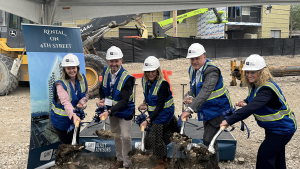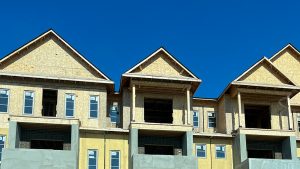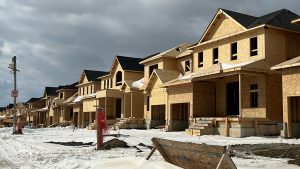BILD Alberta, which represents Alberta developers and residential builders, expects 2024 will be one for the record books after the housing market soared in February to heady heights, said CEO Scott Fash.
“It is caused mostly by unanticipated demand from a large population growth,” said Fash. “We are building more than we have ever built.”
Alberta’s economic dashboard indicated 3,679 housing starts in February, with a year-over-year increase of 65.6 per cent.
The flying hammers are a reflection of the Alberta Finance and Treasury Board tally that Alberta’s population will surpass five million by 2027, reaching six million by 2039. But Alberta is still facing an immediate housing gap of 130,000 to 170,000 dwelling units, according to Canada Mortgage and Housing Corporation’s (CMHC) September 2023 projections for 2030.
Alberta’s housing deficit is an accumulation of shortfalls and ignored markets. The three-legged stool of difficulties, according to Fash, are the ongoing skills and labour shortages, land development and infrastructure costs, and municipalities attempting to struggle with innovations geared to climate change and accessibility.
Aggravating the acute housing shortage has been a 20-year rental housing deficit simply because the profit margins in the past have not attracted developers, Fash said.
Now Alberta rents in February rose at a faster rate than any other province, with major centres seeing a 20 per cent increase.
There is no “silver bullet” remedy, he said, but CMHC’s MLI Select program geared to rental property owners is starting to address housing market shortfalls in 2024 with its insured mortgage for MURBs of five units or more and 95 per cent loan-to-value financing and up to 50 years pay off.
Fash estimates 35 to 40 per cent of what is now under construction are rental units with 17,000 to 18,000 rental units in various stages of completion.
Terry Parker, executive director of Building Trades of Alberta, said the skills shortage in housing is a reflection of the busy industrial and commercial sectors’ willingness to pay higher wages.
In the rush to build, more unskilled individuals are drawn into home construction.
“We are seeing a lot of housing built but it is not the quality or to the standard that has been around for 30 to 40 years,” he said, adding the concern today is another leaky condo episode downstream.
“The trades are getting watered down and we are seeing micro credentials, where the person only knows certain aspect of a trade,” he said, adding this is happening mainly in the non-union sites and is being done to expedite projects.
But, the shortfall is the lack of rounded knowledge journeymen bring and “it hurts the whole apprenticeship system.”
Ray Sullivan, executive director of the Canadian Housing and Renewal Association (CHRA), representing subsidized housing, said for decades the federal government has “downloaded” social housing onto the provincial level.
“It is passing the buck and now it has become a hot potato. There is a crisis and the federal government is stepping back in,” he said.
CHRA commissioned Deloitte Canada to look at community housing, finding that 371,600 new community housing units were needed by 2030 to reach the Organisation for Economic Cooperation average of seven per cent of national housing stock. Deloitte reports by 2030, Alberta will need approximately 44,000 new affordable housing units. The need is 31,000 more units than the Conservative’s plan accounts for.
“Seven is not enough,” said Sullivan, adding even eight per cent is not enough. The severe deficit of community housing has aggravated the homeless and rental situation for low-income individuals.
Sullivan is hopeful recent federal government funding announcements will help. The Housing Accelerator Fund (through CMHC) for municipalities has been what he calls a successful program that can effect change but mainly impacts larger cities such as Calgary and Edmonton where much of the construction is occurring.
Areas such as Calgary and Edmonton are seeing the bulk of residential construction, agrees Fash, while mid-sized towns are not seeing the same activity despite having needs and offering lower costs.
The rural towns are also lagging with housing needs in all fronts, according to the Rural Development Network, a non-profit organization that deals with housing needs in rural, remote and Indigenous communities.
Network capital funding manager Kabir Shahani said: “There are programs but there are also gaps.”
Towns that cannot provide a federally accepted population survey showing they have more than 10,000 residents can not apply for grants.
“These communities are being overlooked,” he said, adding some funds come as loans and are not grants, placing an obligation on municipalities to assume long-term debt.
Alberta Construction Association executive director Warren Singh said Alberta’s construction industry has gone from “first to fifth gear” ramping up to meet residential demand.
But, it is dealing with a layering impact of deficits – skills shortages, lack of investment into prefab industries, supply chain issues – and attempting to deal with emerging climate change demands.
Climate change is being reflected in new building code changes and how various levels of government move on implementation. Alberta is projected to move to a net zero carbon economy by 2050. The industry also still struggles in 2024 for solutions to keep the housing market affordable in light of new demands and higher costs, he said.
“We are not there yet,” he added.












Recent Comments